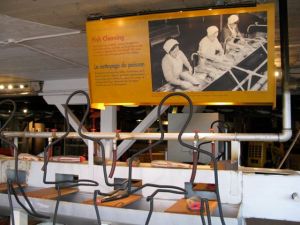
Amidst the reading and writing that has consumed my life, in addition to my Facebook project, I managed to get out of the house yesterday!
I went to see an exhibition on display at the Gulf of Georgia Cannery National Historic Site, out in Steveston (for those not on the west coast, it’s about 15 km south of Vancouver). Steveston is a small fishing village that  attracts many tourists for its waterfront and quaintness, yet, similar to Richmond, has underwent a lot of changes over the years when its farmland was converted into a residential suburb. Until yesterday, I didn’t really know anything about Steveston’s history as a salmon canning centre. The salmon cannery now functions as a museum on a historic site. You can look through the cannery’s website for some information and this slideshow on the Virtual Museum of Canada (VMC) website, but of course it’s not the same as going there in person. Personal contact with objects in a museum can enrich the experience of learning historical information. However, museum displays can frame knowledge in a certain way that might prevent us from really understanding the history of a place and its people. Art can often represent historical narratives in a way that allows participants to enter into the conversation.
attracts many tourists for its waterfront and quaintness, yet, similar to Richmond, has underwent a lot of changes over the years when its farmland was converted into a residential suburb. Until yesterday, I didn’t really know anything about Steveston’s history as a salmon canning centre. The salmon cannery now functions as a museum on a historic site. You can look through the cannery’s website for some information and this slideshow on the Virtual Museum of Canada (VMC) website, but of course it’s not the same as going there in person. Personal contact with objects in a museum can enrich the experience of learning historical information. However, museum displays can frame knowledge in a certain way that might prevent us from really understanding the history of a place and its people. Art can often represent historical narratives in a way that allows participants to enter into the conversation.
Catch + Release is the name of the current art exhibition in the cannery, created by Ruth Beer in collaboration with Kit Grauer and Jim Budd. The artwork is physically separated from the forms and objects that make up the museum tour, however, I can’t help but think about the relationship between the two types of  visual information. Some wooden poles and a few dividers create a division between what is to be understood as art and what is to be understood as museum displays. I was interested in both and was really drawn to the interactive aspect of the video projection work that spanned an entire wall, but just as I am always interested in the connections between the different artworks that make up an exhibition, I found myself thinking about the relationship between the art and the archives. How do they inform one another, and what can we possibly learn from the joining of these two kinds of viewing experiences? How much was the context of the museum considered when creating and displaying the art? I will have the opportunity to explore these questions in future writing so please feel free to comment and/or ask questions below.
visual information. Some wooden poles and a few dividers create a division between what is to be understood as art and what is to be understood as museum displays. I was interested in both and was really drawn to the interactive aspect of the video projection work that spanned an entire wall, but just as I am always interested in the connections between the different artworks that make up an exhibition, I found myself thinking about the relationship between the art and the archives. How do they inform one another, and what can we possibly learn from the joining of these two kinds of viewing experiences? How much was the context of the museum considered when creating and displaying the art? I will have the opportunity to explore these questions in future writing so please feel free to comment and/or ask questions below.
* the first iteration of Catch + Release was shown at VIVO Media Arts in April, 2010.
Below are some short video clips of the exhibition on in Steveston until May 30th – extended to June 7th. The first 3 videos contain no audio.









The relationship between the exhibit and the space of the Cannery was exactly what made this exhibit so radically different from VIVO. It is actually up until June 7 now as very positive public reaction.